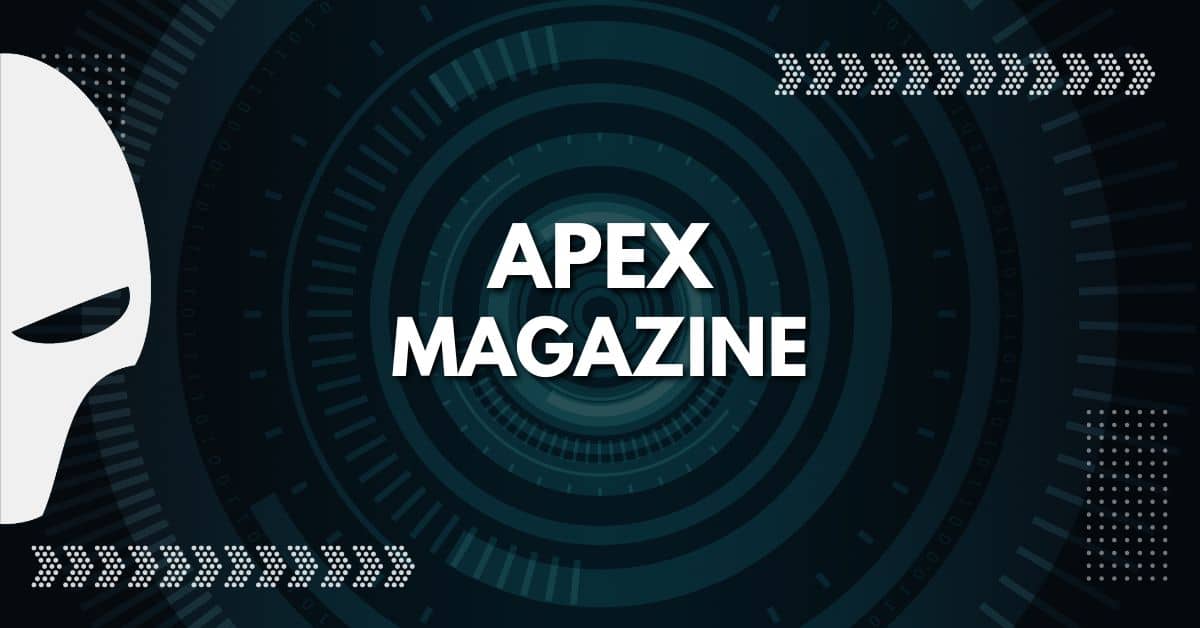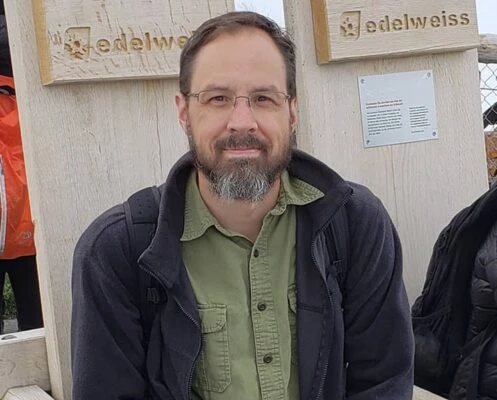
This month’s featured cover artist is Billy Norrby, whose piece “Rock and Claw” beautifully mixes fantasy with reality. Norrby’s work has been featured in dozens of gallery shows and publications, with many works that challenge the real and the unreal.
APEX MAGAZINE: Many of your pieces feature a mix of reality and fantasy, including the giant crustacean of “Rock and Claw.” What is your process for working out angles, perspective, and other techniques with creatures and objects that might only exist in the imagination? How does that differ from painting people and other reality-based objects?
BILLY NORRBY: Indeed, surreal/fantastical elements are prominent in most of my paintings. Despite that, and to the best of my ability, I always try to present each image as having a cohesive and tangible reality of its own. The goal is to have the otherworldly aspects blend seamlessly with the people and environments I’ve photographed in and outside my studio.
Naturally, the logistics behind painting what isn’t there and presenting it in a believable manner to me presents a fun challenge of problem solving. To inform my brush strokes I build models, butcher plastic miniatures, and put together costumes. And I admit that sometimes all the building and sculpting can amount to a certain overkill, but I really enjoy working with my hands and the miniature construction satisfies the kid in me who dreamt of working in special effects of the Ray Harryhausen/Rick Baker variety. Since painting is by its nature a very slow and arduous task compared to many other endeavors, I try to inject as much fun as I can into the process itself. Once I have my sculptures and miniature sets ready and can move on to the painting phase, I’ve actually minimized the difference between painting the “real” stuff and the imaginary elements, because those have also become “real” to a certain extent. My approach of expanding reality into the surreal/dream like realm borrows from very thorough artists like Donato Giancola and James Gurney, whom so effortlessly create utterly believable, boundless worlds.
AM: Your website features three different series—“Pulsar”, “Shadows”, and “The Riot Series”—that each seem to have been completed within certain timeframes. How do you approach other, visually different ideas that might come up during those times?
BN: The separation of my work into these three different categories is not as clear cut as the layout of my website would have it to be. In actuality, the evolution of my work has been a very gradual process with plenty of overlap and darting back and forth over a period of 6-7 years. It was only recently that I took an overall look at my body of work thus far and could see that there were certain paintings which seem to naturally fit together as opposed to other ones. These divisions are thus mostly an afterthought rather than the result of conscious decisions on my part. But certainly, by the nature of the gallery business you often attach a particular theme to an art show, so sometimes it becomes very clear which images fit together in a designated series.
I will also say that the hyper saturated colors of “Pulsar” were a reaction towards the increasingly conservative and romantic streaks my paintings had drifted towards over the last few years. (I have to keep myself excited after all!) But in all seriousness I do believe that a painter is best served by having a clear consistent voice. And I also think that an ambitious artist should strive to evolve and avoid settling into a comfortable space, even if there are clear commercial benefits to do so. Some visual notes aside though, I am still always the same person and artist interested in certain ideas and emotions in general. All my paintings share my particular outlook regardless of differences in subject matter. In time, as my body of work grows, I believe that all perceivable outliers among my paintings will fit neatly back into a larger, logical fold. As an artist, if there are certain images you really want to create that seemingly don’t fit into your current style of work, perhaps that style needs to expand just a bit. Or alternatively, you have to be a little innovative and smart in how you incorporate those new element into your creative language without disruption. I try to just focus on what I sincerely want to paint and not be anxious or spend my nights worrying about what people will think about the work. As long as I paint with conviction I’d like to think that I’m on the right path. :)
AM: On your Tumblr, you show the progress sketches of your piece, “Rise.” Are there differences in sketching out ideas the traditional way with graphite and charcoal versus digital sketches in Photoshop? Or are they complimentary?
BN: It really depends on the project and how much time I am allotted. Naturally the academic purist in me prefers to work on graphite and all the classic materials that make me feel like a “genuine” artist, foolish as that concept might be. But Photoshop is a remarkably useful tool, especially when it comes to creating color and tonal studies within a very short time frame. More important than what tool you use, is how many times you iterate. The best designers among painters, masters like Alphonse Mucha and Leyendecker, left absolutely nothing to chance. They tirelessly created sketches upon sketches until they had perfected all elements of their design. This repetition is a lesson I try to adhere to and the rudimentary way in which I sketch in Photoshop, differs little from how I scribble in my sketchpad.
AM: Your website resume lists galleries that you have shown in, as well as commissioned illustrations for publications. Do you approach illustration commissions differently than gallery pieces, either specifically to individual pieces or overall in your career?
BN: Whenever I’ve been asked to do a commission or an illustration, it has usually been by a client that is already familiar with my work and therefore has a pretty clear view of my visual language and the type of imagery I usually make. As a result the paintings I’ve been asked to create in a commercial setting has by and large fit in pretty well within my natural output and I have never felt creatively compromised to any significant degree. Even with such external assignments, I always try to inject myself as much as possible into each subject matter and make the story my own, regardless of its origin.
Of course there are certain practical considerations when creating an illustration. A so called “fine art” painting is usually meant for the stillness of a gallery or the quiet wall in your home. In that calm, introspective realm there is room to explore more subtle meanings within the artwork, multiple layers that can reveal themselves slowly over the course of repeated viewings. Ideally I want my paintings to have an air of quiet mystery and a sort of “interactive” quality, meaning that the art can plot a course for the viewer by suggesting certain thematic “hooks” and conceptual “riffs”, all while remaining open ended enough that the viewer can inject his or her own imagination onto the piece. Hopefully the end result is the creation of a unique story and meaning that is valuable to each person. So even if I have a very clear set view of what the meaning behind each painting is and what feelings I am hoping to inspire, I prefer not to share every last detail of that story with an art buyer as I don’t want to hamper their own ability to interpret and be creative. A great art experience is a collaboration between artist and viewer after all.
Now an illustration on the other hand belongs in a busy and crowded space, and usually needs to be bolder and more immediate so as to really grab the attention of the hurried consumer. It’s the difference between a slow symphony and a fast rock song. There is room for both forms in my work and each can be as deep and meaningful as the other. I really do try to give an illustration as much thought and love as I would embellish on my fine art, even if the main message needs to be more urgent. In the best of worlds, I am able to create an illustration that is visually arresting, yet also contains those added thematic nuggets and secondary meanings that can unfold to people spending a little more time with the image or taking a particular liking to it.
A good piece is a good piece. If your art speaks to people’s inner lives it will endure, regardless of whether it first appeared on a gallery wall or on a cheap, dinky paperback.
AM: On your Tumblr, you talk about your piece, “Shadow”, and the influences of Soviet statues, Vonnegut, and even Pink Floyd. Do inspirational elements like these show up overtly in other specific pieces, or do your various influences tend to inform your overall body of work? Do those inspirations ever clash, and become something different?
BN: There are artists and influences that echo throughout my work, as with any creative person. Sometimes more overtly, and sometimes hardly visible at all for an end audience even if a particular source was instrumental in the concept’s formation. My artistic heroes and biases are always with me, regardless of what superficial visuals are in an image.
With that said, there are certainly times when I’ve been on a hardcore bender in regards to a particular piece of music, literature, movie, painter, etc and sometimes I can’t help but manifest that directly into whatever I’m working on. No artwork is made in a vacuum after all. How you combine your influences and marry that to your own personality and background is often what sparks a new creative product. There comes a degree of self-therapy in painting. Looking at the repeating elements in my work, I realize that clearly certain ideas and images for whatever reason hold a certain power over me, stirring something deeply in my subconscious. The next question then becomes WHY these particular elements keep resonating? And if I happen to like a certain collection of things, what do they have in common, if anything? Even if a logical connection might be missing, there can be an emotional, Jungian link at play. A dream logic of association that binds one to the other. In the particular case you mention, there might not be a direct link between Soviet statues, SlaughterHouse Five, and The Dark Side of the Moon. But between them there is perhaps a spiritual kinship. In the constellation they’ve been placed in, I have turned them into kindred beasts. At least in my mind, so to speak.
Billy Norrby continues to have new works appear both online and in gallery shows, including at New York City’s Jonathan Levine Gallery for the “Infra: Real” show in August, 2015. See more of his wonderful works on his website at billynorrby.com.









